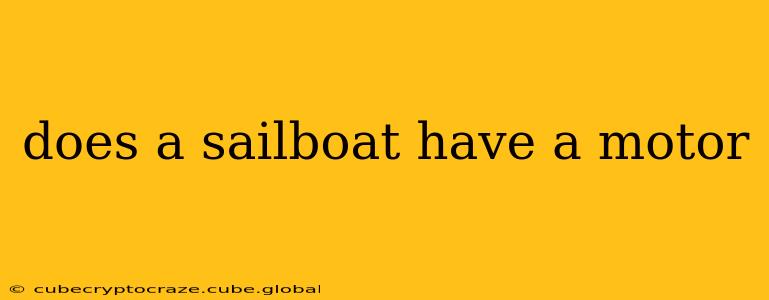Does a Sailboat Have a Motor? The Surprisingly Complex Answer
The simple answer is: sometimes. Whether or not a sailboat has a motor is far from a universal "yes" or "no." It depends heavily on the size, type, and intended use of the vessel. Let's dive into the nuances.
What Types of Sailboats Have Motors?
Many sailboats, particularly those larger than 25 feet, are equipped with auxiliary motors. These are typically small, outboard or inboard engines used for maneuvering in tight spaces, getting into and out of harbors, or for use in conditions where sailing is impossible (like when there's no wind). Think of it as a backup system, or a "get-home" mechanism.
Smaller sailboats, such as dinghies or small day sailers, might not have motors. Their portability and ease of handling often make a motor unnecessary. These boats rely entirely on wind power and human effort (paddles or oars) for propulsion.
Larger cruising sailboats, on the other hand, almost always have motors – often substantial ones – to provide reliable propulsion for extended voyages and to handle challenging conditions.
Why Do Some Sailboats Have Motors, While Others Don't?
The decision of whether or not to install a motor on a sailboat is a complex one, influenced by several factors:
-
Size and Type of Sailboat: Larger vessels, especially those designed for long-distance cruising or offshore sailing, almost always incorporate engines for safety and reliability. Smaller boats may forgo motors to prioritize lightweight design and simplicity.
-
Intended Use: A racing sailboat will likely not have a motor, as weight is a critical factor affecting performance. A cruising sailboat intended for exploring remote areas, however, will almost certainly have one.
-
Budget: Adding a motor significantly increases the cost of a sailboat, both initially and in terms of ongoing maintenance.
-
Personal Preference: Some sailors prioritize the purity of wind-powered sailing and deliberately choose motorless boats.
What Kind of Motor Does a Sailboat Typically Use?
Sailboats typically utilize one of the following types of motors:
-
Outboard Motors: These are easily attached and detached, making them convenient for smaller boats or those who only occasionally need motor power.
-
Inboard Motors: These are installed within the hull of the boat, offering better protection from the elements and generally quieter operation.
How Important Is a Motor on a Sailboat?
The importance of a motor on a sailboat is relative and highly dependent on the context. For some, it’s a crucial safety feature, ensuring they can make it back to shore if the wind dies down or they encounter trouble. For others, it's a convenience that simplifies maneuvering in crowded harbors or navigating calm waters. For racers, the weight penalty might outweigh any benefit.
Ultimately, the decision of whether or not a sailboat needs a motor is a personal one, informed by the intended use, budget, and sailing experience of the owner.
Do all sailboats have to have a motor?
No, sailboats are not legally required to have motors in most places. However, the presence of a motor is often a practical necessity, enhancing safety and utility for many sailors, particularly in certain types of sailing or locations.
What are the benefits of having a motor on a sailboat?
The main benefits include enhanced safety (ability to reach shore in calm weather), easier maneuvering in harbors and tight spaces, and the ability to make progress in windless conditions.
This nuanced look into the world of sailboat motors should help clarify why the simple question of whether all sailboats have motors doesn't have a simple yes or no answer.
